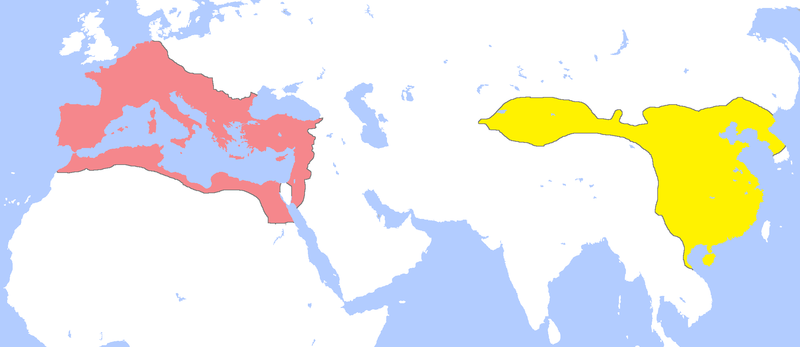The histories of Rome and the Han Dynasty are epic tales of powerful empires that flourished in their respective corners of the ancient world.
Rome, with its Mediterranean dominance, and the Han Dynasty, ruling over vast swathes of East Asia, represent two of the most enduring and influential civilizations in human history.
Despite their geographical separation, they were connected through a complex web of trade, diplomacy, and cultural diffusion, albeit indirectly. This article explores the multifaceted interactions between these great empires, shedding light on the fascinating connections and agreements that have intrigued historians for centuries.
Historical Background
The Roman Empire, established in 27 BC, was a formidable superpower that spanned three continents. It left an indelible mark on the Western world through its legal systems, engineering marvels, and the spread of Latin and Christianity.
Meanwhile, the Han Dynasty, which began in 206 BC, presided over a vast empire in East Asia, contributing significantly to fields such as astronomy, medicine, and the invention of paper.
Both empires, though thousands of miles apart, were instrumental in shaping the course of human civilization.
Silk Road: The Ancient Trade Network
The Silk Road serves as the quintessential link between Rome and China, spanning over 4,000 miles. It was not merely a trade route; it was a bridge for the exchange of ideas, technologies, and cultures.
The flow of goods, including silk, spices, precious metals, and exotic animals, played a pivotal role in connecting the Roman and Han economies.
Geographical Separation
The vast geographical distance between Rome and China presented significant barriers to direct contact. These barriers included the expansive Parthian Empire and the presence of nomadic tribes in Central Asia.
These obstacles made direct interactions between the two empires exceptionally challenging.
Indirect Contacts
While direct communication was limited, indirect contacts thrived. The Parthian Empire acted as a mediator, facilitating trade and communication between Rome and China. Nomadic tribes, such as the Xiongnu, played a crucial role in facilitating the movement of goods along the Silk Road.
Cultural Exchange
The Silk Road was not merely a conduit for goods but also a pathway for cultural exchange. The exchange of ideas, philosophies, and artistic styles between East and West left an indelible mark on both Roman and Chinese cultures.
This cross-pollination of ideas continues to resonate in modern times.
Diplomatic Missions
Diplomatic missions between Rome and China were rare but not unheard of. Notable instances include the embassy of Gan Ying, a Han envoy who reached the eastern shores of the Roman Empire.
These missions aimed to establish diplomatic relations and explore potential alliances.
Rome and the Hellenistic East
The eastern part of the Roman Empire, known as the Eastern Roman or Byzantine Empire, was heavily influenced by Hellenistic culture.
This Hellenistic legacy, combined with Roman authority, created a unique blend of cultures in the Eastern Mediterranean. This cultural fusion may have indirectly connected with Chinese culture through the Silk Road.
Archaeological Evidence
Archaeological findings have offered intriguing clues about possible direct interactions. Roman artifacts, such as glassware and coins, have been discovered in China, and Chinese artifacts, including pottery and lacquerware, have been found in Rome. These discoveries suggest limited direct contact.
Written Accounts
Written records and accounts from ancient historians, explorers, and diplomats offer tantalizing hints of possible interactions between Rome and China.
However, interpreting these historical texts requires careful consideration, as they often contain gaps and ambiguities.
Theories of Direct Connections
Historians and scholars have proposed various theories suggesting direct Roman-Han interactions. These theories range from the presence of Roman legionaries in China to the idea of a Roman embassy in the Han capital. Each theory presents its own set of challenges and controversies.
The Role of Religion
Religious ideas, such as Buddhism and Christianity, traveled along trade routes and may have played a role in cross-cultural communication. The spread of these faiths could have indirectly influenced the beliefs and practices of people in both empires.
Legacy and Impact
Uncovering the extent of Roman-Han connections is not merely an exercise in historical curiosity. It has profound implications for understanding the broader sweep of history.
The exchange of knowledge, technologies, and goods between Rome and China may have had a lasting impact on subsequent civilizations.
The Decline and Fall
The decline and fall of both the Roman Empire and the Han Dynasty are complex phenomena with multiple contributing factors.
While connections with each other were not the primary cause of their decline, they are part of the intricate tapestry of historical events that shaped their destinies.
Conclusion
In conclusion, the question of whether the ancient Romans had connections or agreements with the Han Dynasty and the Chinese people is a topic that continues to captivate historians and scholars.
While direct contact between these two great empires was limited, the Silk Road, as a conduit for trade and cultural exchange, served as a vital link between them. Indirect contacts, diplomatic missions, and the exchange of ideas and artifacts hint at the possibility of deeper connections.
Unraveling the enigma of Roman-Han interactions enriches our understanding of the ancient world and underscores the interconnectedness of human history across vast distances and diverse cultures.
